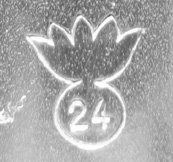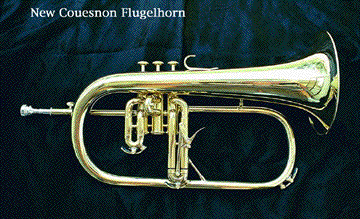Q: Whatever happened to Couesnon?
Couesnon is one of the great names in brass instruments, in business over 170 years. It grew to include eight factories employing, at one time, over 1800 people in France. In the USA in the 1950s, the Couesnon flugelhorn became very popular as a doubling instrument for jazz trumpet artists. Their flugelhorn sounded great, was readily available, and was cheap. They were everywhere. Its design is copied by the overwhelming majority of instrument makers who now make and market flugelhorns.
Why is it, then, that one can no longer buy such a popular instrument?
A:
Actually, you can. Here's the story.
The Couesnon company was started in 1827, in Château Thierry, a small city on the Marne River, 50 miles east of Paris, an area traditionally associated with the making of brass instruments, according to Richard Dundas, in his book, Twentieth Century Brass Musical Instruments in the Twentieth Century (third edition). The company was purchased by the Couesnon family in 1883 and already had an outstanding reputation as a maker of fine instruments. The production included percussion, woodwinds (including double reeds), small and large brasses, and military bugles. Under the personal direction of Amedee Couesnon for 48 years, the company won many medals and awards for quality production and technical innovation.
They made many horns which were imported into the United States, including many that were sold under the names of music stores and other private labels.
By 1911, Couesnon had expanded to eleven factories and more than 1000 workers, meeting the needs of many performing groups and military bands. During this time the products were highly sought after and were played by many of the virtuosos at the time. To get a sense of this, take a look at the Couesnon 1915 Catalog. Although they made virtually any musical instrument, during the 1930s they began catering to "Fanfare bands" (marching brass bands very popular at the time), and gradually became almost the only supplier of marching brass instruments in France. At this same time, prior to the war, the Couesnon trumpet factory in Paris was located right next door to the F. Besson trumpet factory, where the premiere trumpets prior to World War II were made. Curiously, the Couesnon trumpets of the time look virtually identical to the F. Besson models.
At the end of World War II, the music business started to change, but Couesnon continued to deal primarily with the special needs and instruments of brass and military bands. The C/Bb trumpet market became dominated by Selmer, Courtois, LeBlanc in France and even the larger American manufacturers. The public continued to associate Couesnon with the brass band; not the orchestral or jazz band. Starting in the 60 's and during the next 20 years, Couesnon tried to expand its share in markets other than fanfare bands. They made a line called "Monopole Conservatoire" higher quality instruments, trying to gain more customers in conservatory (music students). For example, they employed Mr Bernard Soustrot (first prize in the 1976 Maurice André Competition in Paris) to try all the piccolos trumpets made in the workshop and to give his "blessing" to these new instruments. Unfortunately, these efforts proved ultimately ineffective, and their traditional market continued to decrease in popularity to the point that brass bands have almost all disappeared in France. According to Richard Dundas, sixty percent of the production was exported throughout the world with as much thirty percent sold in the United States. However, as sales declined, the profits dwindled and the losses mounted. Factories were sold off and in 1969 the main factory in Château Thierry was badly damaged by fire, destroying the archives. In 1978, the contract with Gretch to import Couesnon instruments to the United States was terminated and new Couesnon instruments have been very rare in the US since that time.
The fire resulted in loss of all the company records, including those which would make it possible to determine the year of manufacture from the serial number. This question arises all the time and there appears simply to be no information available. I've tried over a number of years to see if anybody in the US or France has this information, or any key to the odd numbers that are found stamped all over some Couesnon instruments. There seems to be no key or pattern to them. And worse yet, so very few Couesnon instruments are in the hands of the original owners that attempting to establish a data base of serial numbers and date of manufacture (as has been successfully done with Benge trumpets) is impossible. For a while one major retailer of used instruments used to attach dates of manufacture on the Couesnons they were selling based on the serial numbers. I inquired as to where they were getting that information (only wishing to provide web space for it), they answered vaguely and then discontinued the practice entirely without explanation. Sorry about that.
Here, however, might be some good news: Steve H., a correspondent
who has purchased several Couesnons, writes:
A customer in France who deals in vintage horns gave me this info which seems to work, judging by condition and styling of various examples. In the "grenade," the circle with flame coming out of the top [editor's note: some people think that it's 'the pineapple,' pictured nearby, and they only appear on some instruments], below the word PARIS is a number which indicates the year of manufacture, 6 would mean 1906, 24 would mean 1924, 65 means 1965 and so forth.
So, everybody take a look. Matching the estimated age of your Couesnon with the number described, If you think it might be possible that it is the date of manufacture, please let me know.
 Although
today the company has only 25 employees working in its sole shop in
Château Thierry, Couesnon is still in business. In 1999, the
French drum maker P.G.M. bought the name, the tooling, and the
factory to give it new life. The company is now known as P.G.M.
Cousenon. Their most popular products are hunting horns and tambour
drums mainly for the French market. Unfortunately all the mandrels
and tooling needed for the making of C, Bb and piccolo trumpets had
been stolen, so the workshop is making only brass band instruments,
such as the flugelhorn ("bugle" in French), cornet, tuba, a true
French French horn, with piston valves and extended stems for left
hand operation, hunting horns, and a natural trumpet (Jeanne of Arc
model) and of course military bugles ("clarion" in French) including
bass bugles, cavalry trumpets and so forth. Many of these instruments
have unique designs. As the instruments are hand made in very small
quantities, the quality, I am told, is exceptional.
Although
today the company has only 25 employees working in its sole shop in
Château Thierry, Couesnon is still in business. In 1999, the
French drum maker P.G.M. bought the name, the tooling, and the
factory to give it new life. The company is now known as P.G.M.
Cousenon. Their most popular products are hunting horns and tambour
drums mainly for the French market. Unfortunately all the mandrels
and tooling needed for the making of C, Bb and piccolo trumpets had
been stolen, so the workshop is making only brass band instruments,
such as the flugelhorn ("bugle" in French), cornet, tuba, a true
French French horn, with piston valves and extended stems for left
hand operation, hunting horns, and a natural trumpet (Jeanne of Arc
model) and of course military bugles ("clarion" in French) including
bass bugles, cavalry trumpets and so forth. Many of these instruments
have unique designs. As the instruments are hand made in very small
quantities, the quality, I am told, is exceptional.
The company is now a very small family owned business whose ownership is found in the company's name, P.G.M.
P comes from the family name Planson, the owner of the drum company who bought Couesnon in 1999. Both mother and father work at the company, mother in the office and father in the production. They have two daughters Sophie and Isabelle who actually own the company today.
G comes from Sophie's married name which is Glace. She runs the company now, and her husband Stephan Glace works as production manager.
M comes from Isabelle's married name which is Moret. She is a sewer and makes instrument bags. Her husband does not work at the company.
The company is all situated in one building, containing office, manufacturing, storage, and lacquering. Only silverplating and case making are done elsewhere. Production facilities are old-fashioned and the employees are skilled hand craftsmen, somewhat similar to Schilke--no computer controlled devices and just a little electromechanical machinery. All of the Couesnon instruments are to be regarded as handmade. Strangely enough nobody at the factory could play, at least not a flugelhorn, and professionals musicians were called in for the final testing.
They make three flugelhorn models, to wit:
- 137 Tradition, which is the small one (2003 price 1031 Euro, in lacquered version which is standard),
- 142 Monopole (1721 Euro) and a 142 CR (Cuivre Rose) which has rose brass bell (1892 Euro).
- 144 which is the 4 valve version (1804 Euro).
I've heard rumors of an all copper version and silverplating is available on request for all models except the 142 CR.
Production of flugelhorns is about 50-60 a year, and except from a few sold in France, most are sold to Japan. Because the production is so small, they are not found in large quantities in music stores, even in France. There are no distributors. Thus, the only way to acquire a new Couesnon instrument is to order directly from the factory.The company struggles and its marketing efforts are from the same age as the tooling. They don't have a web-site, they don't have e-mail, they don't take credit cards, and they don't seem to have a distribution network. Communications and transportation to Chateau Thierry is poor . There are only a few trains to/from Paris, and no buses. No brochure could be found anywhere in Paris, only in their office.
Couesnon can be reached by phone at 0323835675 (Sophie Glace, who answers the phone, speaks pretty good English), and by fax 0323836797 (responses are somewhat slow in coming).
In January 2005, PGM-Couesnon slipped quietly into the computer age, launching their own website. It is visible in both French and English.
I'm indebted to Jean-Michel Souche, a young French trumpet player and teacher who was able to research and tell me much of the information about the current status of the company and its products. I am also grateful for Olaf Brattegaard of Oslo, Norway, who visited the company in February 2003 and reported to me much additional and more current information. Feel free to contact Mssr. Souche if you are interested in any of these products or Mr. Brattegaard if you have more questions. For the 1915 Couesnon catalog link, I'm grateful to Jean Monange.
© 2000 - 2007 by James F.
Donaldson
All rights reserved